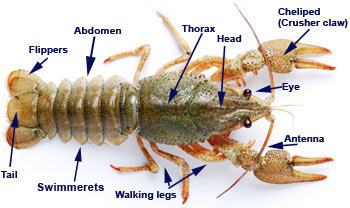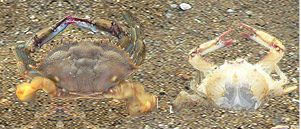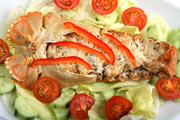Crustaceans

The major groups of Crustaceans

|
Crustaceans (make up a very large group of the Arthropods which include the crabs, lobsters, crayfish, shrimp, krill, barnacles brine shrimp, copepods, ostracods and mantis shrimp. Crustaceans are found in a wide range of habitats - most are free-living freshwater or marine animals, but some are terrestrial (e.g. woodlice), some are parasitic (e.g. fish lice) and some do not move (e.g. barnacles). |
There are over 50,000 known species of crustaceans divided into a number of major groups - the Branchiopods, the Maxillopods, the Ostracods and the Malacostraca. The Malacostraca are further divided into five groups - decapods (e.g. crabs, lobsters and shrimp), stomatopods (mantis shrimp), euphausiids (krill), amphipods (e.g. sandhoppers) and isopods (land-based) crustaceans.
Crustaceans are invertebrates with a hard exoskeleton (carapace), a segmented body that is bilaterally symmetrical, more than four pairs of jointed appendages ("legs") and an open circulatory system (the "blood" does not flow in a closed loop). They also have eyes usually on stalks, a primitive ventral nerve cord and "brain" (ganglia near the antennae), a digestive system which is a straight tube for grinding food and a pair of digestive glands. Gills are used for respiration and they have a pair of green glands to excrete wastes (found near the base of the antennae). |
|
| |
|
| Their bodies are composed of three body segments - the head, the thorax and the abdomen. In some species the head and thorax are fused together to form a cephalothorax which is covered by a single large carapace.
Each or body segment can have a pair of appendages. For example, the Malacostra have a head with 5 segments,a thorax with 8 segments and the abdomen has 6 segments.
On the segments of the head, these include two pairs of sensory antennae, one pair of mandibles (for chewing food), and two pairs of maxillae (to help the mandibles in positioning the food). The thorax has legs, which may be specialised for use in walking or feeding. The abdomen has legs usually used for swimming (swimmerets) and ends in a fan-shaped tail (telson). |

|
| |
|


|
Most Crustaceans are either male or female and reproduce sexually. A small number, including barnacles, are hermaphrodites. In other species, viable eggs are produced by a female without needing to be fertilised by a male.
In many decapods, the first one or two pairs of swimmerets are specialised for sperm transfer by the males and the females hold the eggs until they hatch into free-swimming larvae. In many species the fertilised eggs are just released into the water or attached to objects in the water.
The larvae metamorphose through a number of stages before they become adults.
Most Crustaceans are motile (able to move about independently) and can be herbivores, carnivores or detritvores. Some are parasites and live attached to their hosts (e.g. fish lice). |
| |
|
|
|
| Marine crustaceans have a very wide range of predators from mammals like sea otters and seals, other crustaceans, molluscs (e.g. octopuses), sea birds, fish and humans. They protect themselves by a variety of methods - their hard exoskeletons, their chelipeds, camouflage and rapid escape (burrowing or swimming away). |
| |
|
Their sizes range from the Japanese spider crab with a leg span of 4.3 m to the smallest, a parasite of copepods, which is only 0.1 mm long.
As a crustacean grows, its exoskeleton does not, so the animal must moult its old exoskeleton in order to house its expanding body. To prepare for moulting, the tissue layer under the exoskeleton detaches and secretes a new exoskeleton below the hard outer one. When the new exoskeleton is completely formed, the old exoskeleton splits along weak points and the animal pulls out, leaving its old exoskeleton intact except for the split. After a moult the animal must wait and often hide until the new exoskeleton hardens. |

|
| |
|

|
Many crustaceans, especially the larger decapods (crabs, lobsters, shrimp, and prawns) are eaten by humans and are therefore important to human economies. Krill are also caught in large amounts.
Small planktonic crustaceans, such as copepods, water fleas, and krill, are major links between the photosynthetic phytoplankton and larger carnivores such as fish and whales in marine food webs. Other crustaceans are crucial in recycling nutrients trapped in the bodies of dead organisms. |
|
References
http://en.wikipedia.org/wiki/Crustacean
www.enchantedlearning.com/subjects/invertebrates/crustacean/
www.earthlife.net/inverts/crustacea.html
http://animals.howstuffworks.com/marine-life/crustaceans.htm
Thanks to
I would sincerely like to thank the many members of the Flickr community who have given me permission to use their wonderful images for this unit. Their contributions really make this unit come alive!
Next: Branchiopods ... |
|